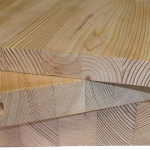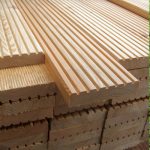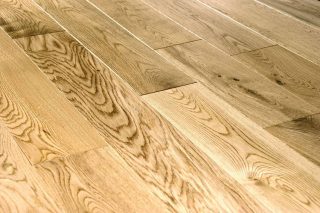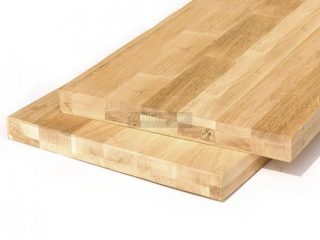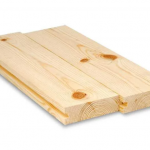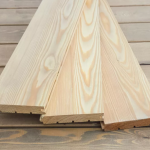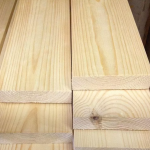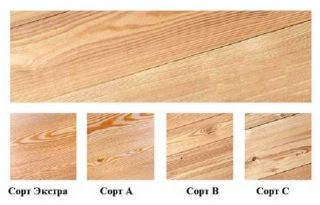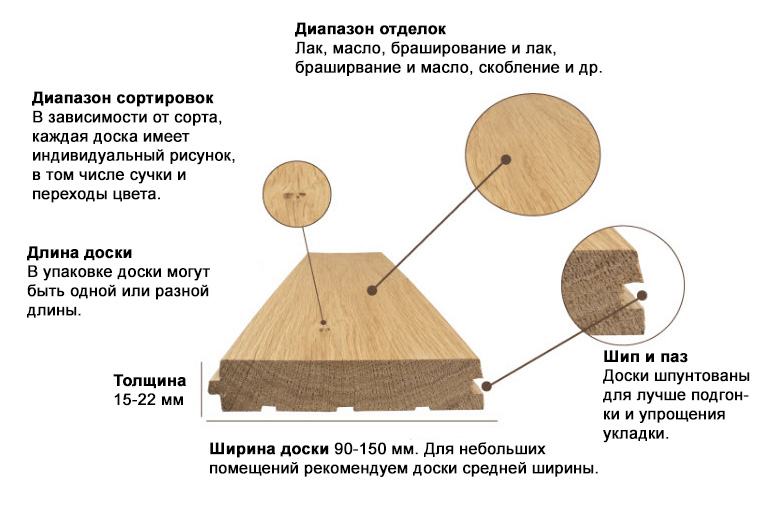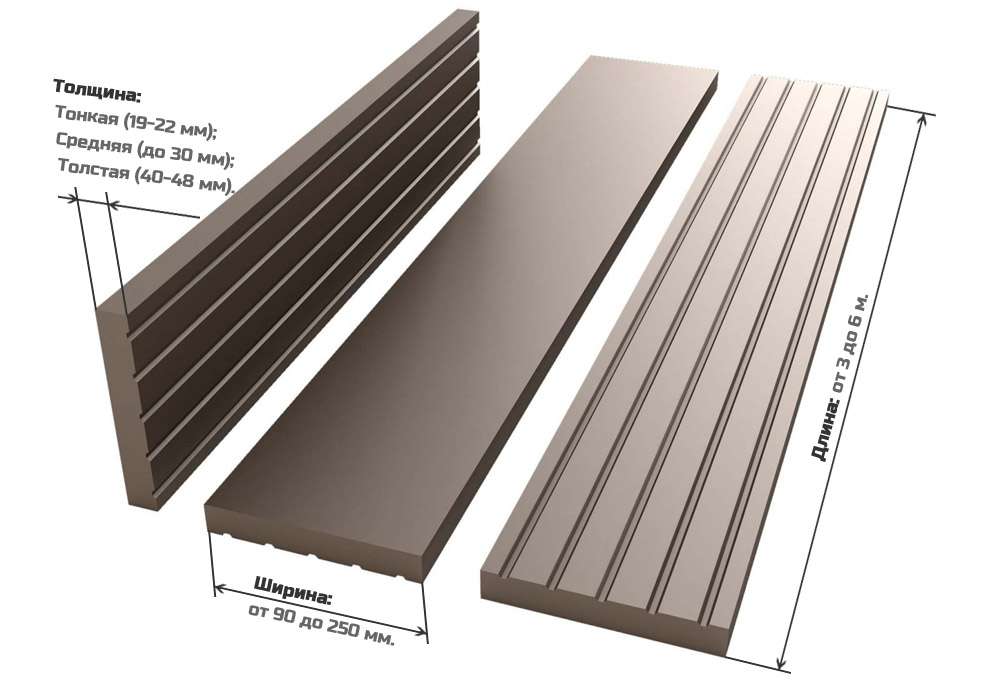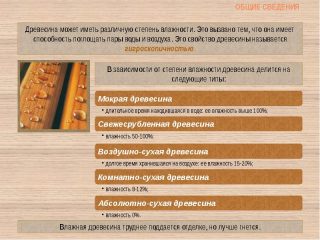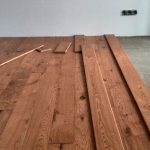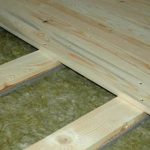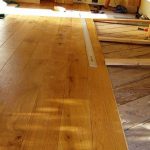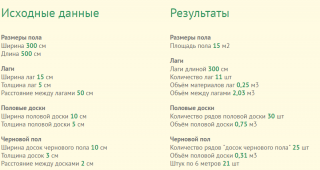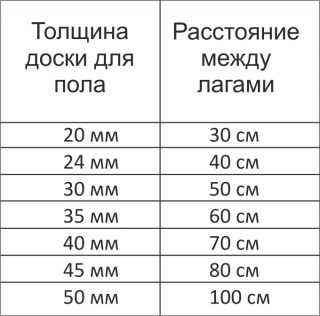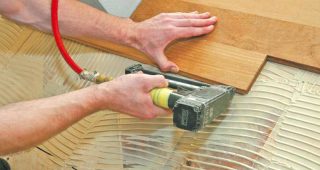The floorboard is a profile milled lumber. The elements are joined using a groove-comb attachment. The coating can withstand several rounds. The width of the floorboard is taken taking into account the load, the size of the room and the type of wood. On the inner side, recesses (cuts) are provided, which prevent deformation during temperature fluctuations.
Description and varieties of floorboards
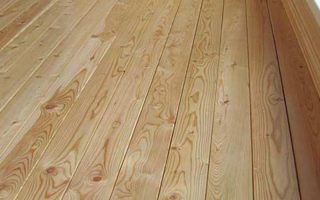
Durable and reliable flooring material is made of natural wood, so it retains all its characteristics during operation.
Floorboard qualities:
- has anti-allergenic properties, environmentally friendly, does not harm health;
- does not conduct electricity;
- additionally protects the room from cold, sounds.
Raw material cannot be moisturized, in damp conditions, mold, rot, various microorganisms, bugs develop. Planks impregnated with antiseptics, fire retardants at the factory, or they need to be protected at home when installing the floor.
Distinguish types of boards:
- made of solid wood;
- glued prefabricated;
- terraced.
Boards are usually soft, poorly resistant to abrasion, so they are coated with hardening multicomponent paints and varnishes. The protective film requires regular renewal.
On all sides, grooves and protrusions are provided for a tight connection; chamfers with a size of 0.5 mm are made around the perimeter. The front side is high quality sanded, without irregularities and scoring.
Solid wood
Difference from standard material:
- they are made more often of solid wood, therefore it has a greater bearing capacity;
- requires a solid base for laying;
- massive boards look like block parquet with increased dimensions;
- on the surface there is a large picturesque pattern of fibers, annual rings.

Unlike a standard board, a massive one is not covered with colored paints, only stains, toned varnishes are used to preserve the drawing. The technique of brushing, bleaching, patination is applied.
Glued
The qualities of glued floor boards:
- does not dry out, does not change geometry with temperature jumps;
- withstands significant loads, since it has less stress than massive boards;
- keeps well in damp rooms, differs in a low degree of moisture absorption;
- dry wood is chosen for production or dried in chambers, so the coating is not afraid of negative temperatures and shrinkage.
Dimensions (edit) floorboard from component parts always accurately maintainedtherefore it is easy to fit it into the floor structure. Such a coating is successfully used in rooms where many people pass during the day. In children's rooms, the material is also indispensable in order to simultaneously create a beautiful look and ensure endurance.
Terrace
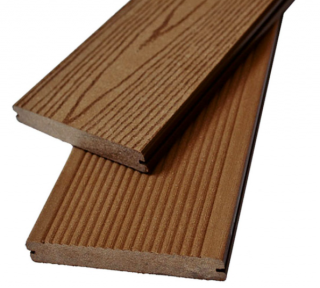
Use for work in difficult conditions, for example, outdoors, in damp rooms. The board is placed for covering on verandas without heating, balconies, terraces. The material has proven itself well in the construction of floors in baths, saunas are used for flooring in the garage, gazebo, under awnings, around pools. In another way, the terraced option is called garden parquet.
Surface terrace boards are:
- smooth (planken);
- corrugated (corduroy).
In the open air, the material does not lose its original qualities. On the invisible side there is compensation grooves or cuts to relieve stress from low temperatures and hot sunlight. The planking elements are installed with a small gap to provide freedom for expansion.
Products during manufacturing process wax, oil or a combination of these materials. Manufacturers monitor the moisture content of the material, since poorly dried parts will begin to deform after the first season.
Wood species

The material of the floorboard can be various woods, only linden and poplar are not used... Soft rocks are treated with persistent paints and varnishes. All types are distinguished by a unique texture of fibers and rings, color, shade, properties.
Characteristic of different breeds for the manufacture of floorboards:
- Oak. Withstands great effort, shock, moisture. Provides increased heat and sound protection, is not subject to decay, mold.
- Larch. The wear-resistant coating is naturally moisture resistant and releases useful elements into the air.
- Spruce withstands less loads, but it is easily processed with a tool and does not conduct heat well, has a good smell, lets in vapors (breathes).
- Pine. Stronger than spruce, tougher, with higher wear resistance. Both breeds contain resin, which gives them additional protection from dampness.
- Fir contains few resinous compounds, therefore more careful processing is needed.

Quality classes
There are generally recognized board classes:
- Extra. The products do not have a single flaw on the surface. Planks are even, with clearly consistent dimensions. The cost of such a board is high, since it is difficult to find areas without knots in a felled trunk in order to approach the standard.
- Class A. Allowed per running meter of sawn timber 1 live knot (without falling out) and the minimum number of cracks not at full depth. For manufacturing, the middle part of thick logs is often used.
- Class B. Allow 2 knots or resin pockets per linear meter, one crack (up to 3 cm) or chip, as well as indistinct darkening in the form of separate spots.
The most substandard is considered class C... Up to 4 knots or resin pockets, chips, irregularities, cracks are allowed per running meter. Allow a violation of the geometry of the groove or ledge, the curvature of the boards.
Floorboard dimensions
Massive board is packed on a one-length and multi-length principle. In the first version, the pack contains the same elements, in the second - one piece along the length of the floorboard, several short ones. This saves material and creates a beautiful combination when styling. Solid board has dimensions: width 90 - 150 mm, length 300 - 900 mm, thickness 16 - 40 mm.
Terrace board produced up to 6 m long, 90 - 250 mm wide, up to 48 mm thick.For rectangular sections, set the same details, corner rooms and rooms in the form of the letter G are typed with elements of different lengths.
Glued board produced in dimensions: width 120 - 150 mm, thickness ranges from 18 - 50 mm, lengths of boards are from 1.5 to 6.0 meters. Elements are installed parallel to the sides of the site, sometimes placed diagonally. The last model of the floor is obtained with an overexpenditure of material for trimming corners.
What to look for when choosing
Features of choice:
- Pay attention to thickness boards. For housing, a thickness of 20 - 25 mm is sufficient, since there is no heavy load in the rooms. For corridors, verandas, garages, a parameter of 30 - 35 - 40 mm is used in order to be able to scrape the surface during repairs.
- Check correct size... Take into account the uniformity of the edges, warping of the elements. Inspect the products for fiber delamination, the presence of mold, rot on the ends.

Laying the floorboard
Before installation, sawn timber brought into the room, left for a weekso that the wood gets used to the temperature and humidity conditions.
The board can be placed on base of materials:
- concrete and cement screed;
- plywood, OSB, hardboard;
- wooden and metal logs;
- old flooring from boards, parquet.
In the process install insulation - mineral wool, polystyrene foam, polystyrene foam are used. There should be a gap of 2 - 4 cm from the upper surface of the insulation to the boardwalk for ventilation. The smaller the thickness of the boards, the more the elements will bend when receiving efforts. Therefore, a reliable base is formed for thin elements.
Planks are laid in the room in the direction of incoming light from the windows, in the corridor are located in the direction of travelto make the seams less visible. They fix the flooring elements in a hidden way, on special fasteners or self-tapping screws. A compensation gap 1 - 2 cm wide is left along the perimeter of the walls.
How to calculate the quantity
The procedure for calculating the number of boards in a cube:
- determine the volume of one element, for this, multiply the length by the height and width;
- the cubic meter is divided by the result obtained and the quantity in pieces is obtained.
You can count the number of boards for one room according to the width of the room. For example, you need to fill in an area of 4 x 5 m, the boards will be laid along the side with a length of 5 m.For laying, lumber 150 mm wide, 25 mm thick, 5 m long were selected.
Calculation procedure:
- divide 4.0 m by 0.15 m, get 26.7 boards, take 27 pieces;
- multiply 0.15 m by 5.0 m, by 0.025 m, get the volume of one board (0.0187 m³);
- the resulting value is multiplied by 27 pieces, you get 0.467 m³ - this is how much you need to purchase.
To account for cutting, the resulting volume is multiplied by a factor of 1.05, and a value of 0.49 m³ is obtained.
Laying on logs
Rules for installing the lag and fixing the flooring:
- the step between the lags is taken by calculation, taking into account the thickness of the boards, width and load;
- logs to a concrete slab, screed are fastened with dowels, sometimes they are planted in a mortar;
- a waterproofing film is used to protect against moisture;
- the elements fit the spike into the groove, the first element is placed with the spike against the wall.

Fastening with construction adhesive
This method requires careful foundation preparation:
- leveling the plane with a screed, repair mortar;
- a primer with deeply penetrating preparations;
- installation of a plywood sublayer on a dry base.
Lumber is put on glue using screws or parquet pins. Their purpose is to anchor the flooring until the adhesive is dry.


